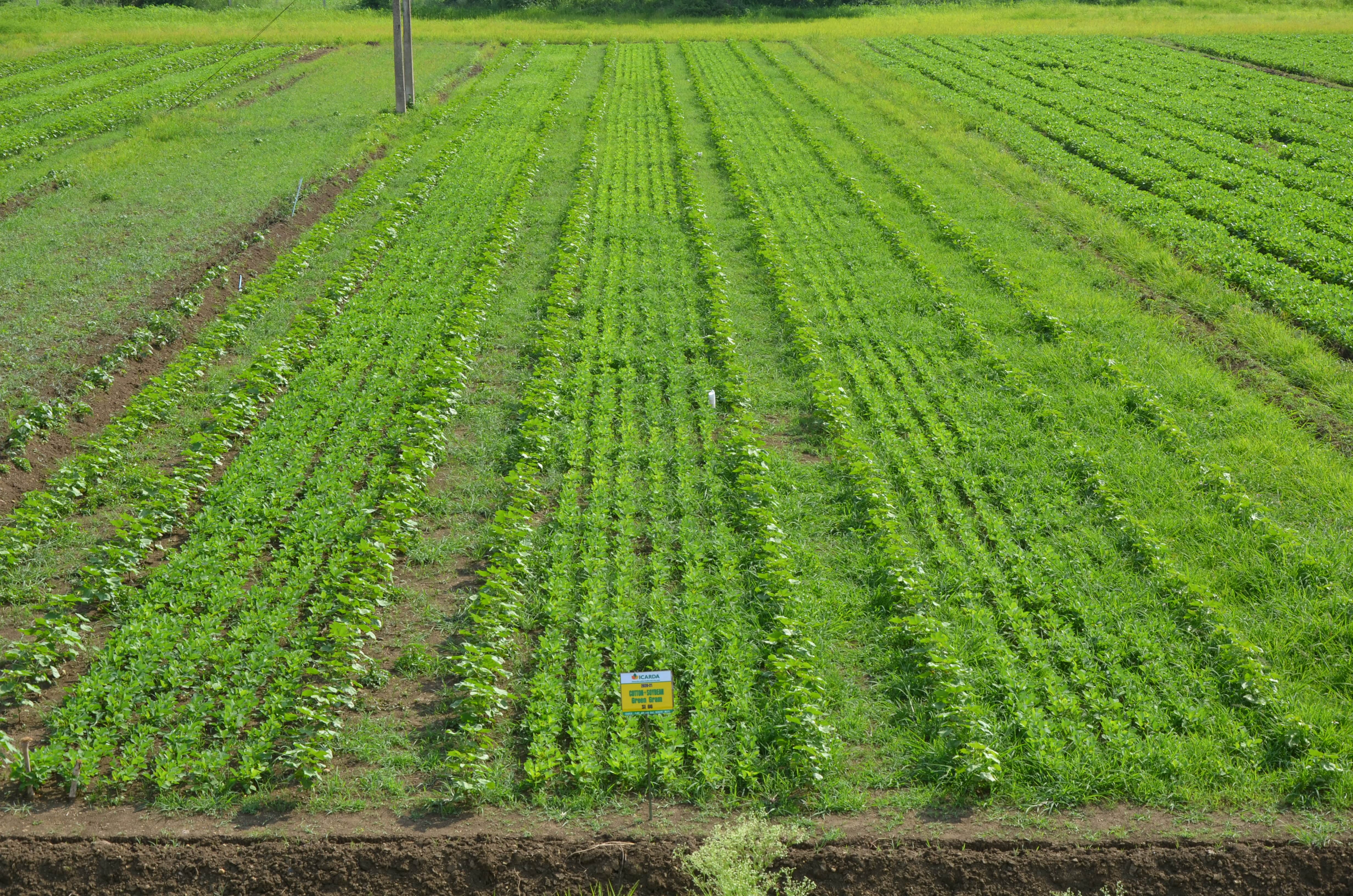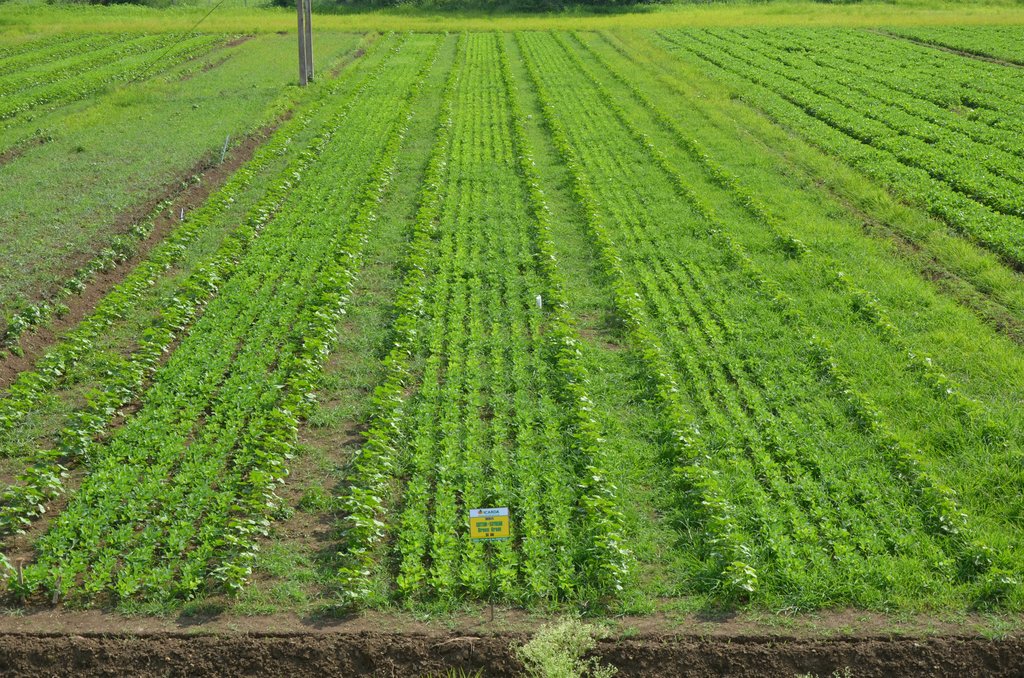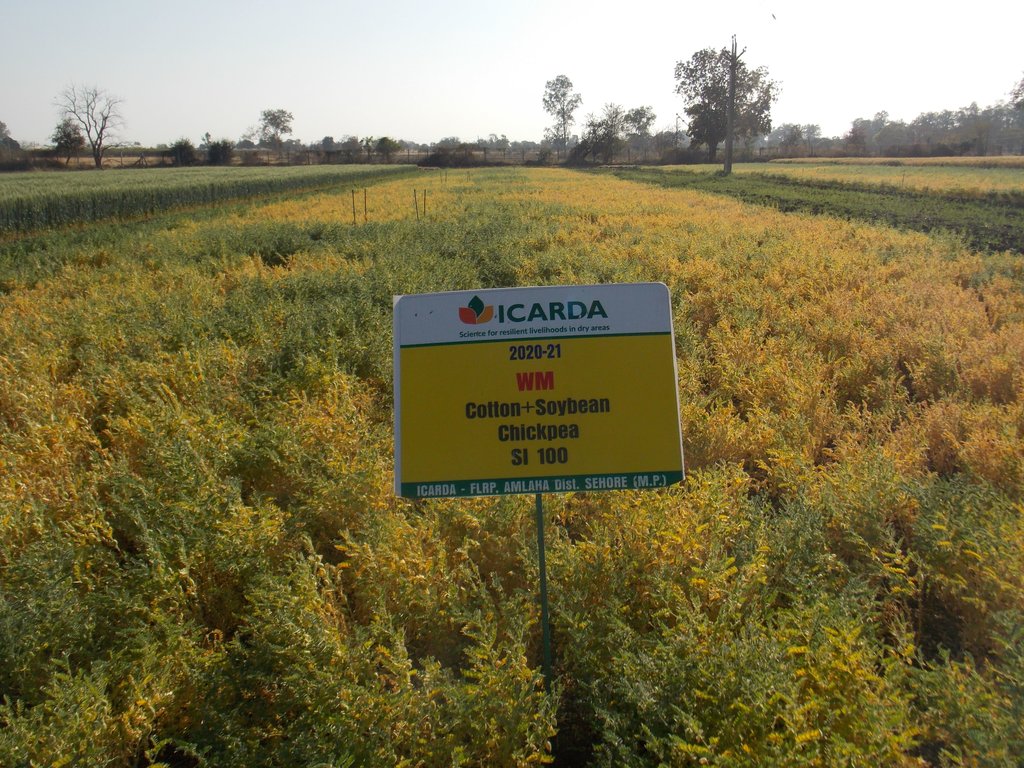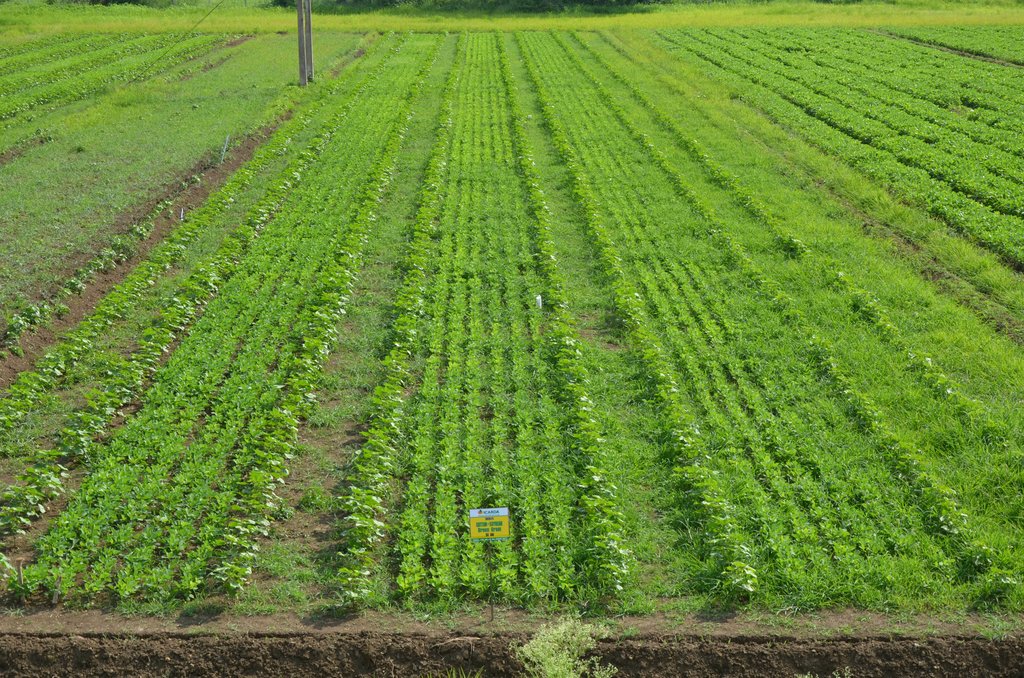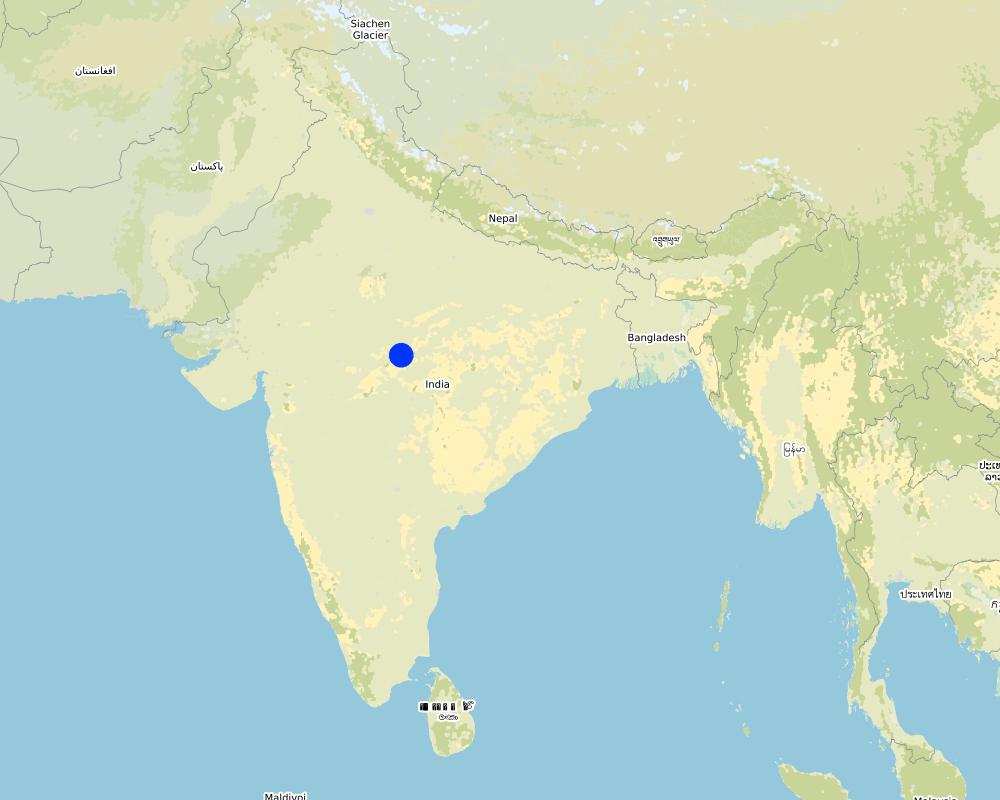Supplemental Irrigation in a Legume-Cotton Production System [India]
- Creation:
- Update:
- Compiler: Joren Verbist
- Editor: –
- Reviewers: William Critchley, Rima Mekdaschi Studer
technologies_5820 - India
View sections
Expand all Collapse all1. General information
1.2 Contact details of resource persons and institutions involved in the assessment and documentation of the Technology
Key resource person(s)
Research Team Leader - Soils, Waters and Agronomy:
Nangia Vinay
International Center of Agriculture Research in the Dry Areas (ICARDA)
Morocco
Research Associate Agronomy:
Sinha Rajni
International Center of Agriculture Research in the Dry Areas (ICARDA)
India
Name of project which facilitated the documentation/ evaluation of the Technology (if relevant)
ICARDA Institutional Knowledge Management InitiativeName of the institution(s) which facilitated the documentation/ evaluation of the Technology (if relevant)
International Center for Agricultural Research in the Dry Areas (ICARDA) - Lebanon1.3 Conditions regarding the use of data documented through WOCAT
The compiler and key resource person(s) accept the conditions regarding the use of data documented through WOCAT:
Yes
1.4 Declaration on sustainability of the described Technology
Is the Technology described here problematic with regard to land degradation, so that it cannot be declared a sustainable land management technology?
No
2. Description of the SLM Technology
2.1 Short description of the Technology
Definition of the Technology:
Supplemental Irrigation (SI) offers a solution for irregular rainfall, as it provides a limited amount of water to essentially rainfed crops consequently ensuring good plant growth. Furthermore, SI provides the opportunity for a more diverse production system such as a legume-cotton system in which chickpeas are cultivated as a winter crop, and soybean and cotton are inter-cropped in the summer.
2.2 Detailed description of the Technology
Description:
The state of Madhya Pradesh (India) has an average annual rainfall of around 1170 mm. However, data shows a declining trend. It is characterized by a monsoon period from July to September. Winter is from December to January and the summer is from February to March. The rainfall is irregular, resulting in crop failures, land degradation, nutrient leaching and shortened growing seasons. This constrains the agricultural sector, upon which 74% of the population is either directly or indirectly dependent. 38% of the agricultural area is intensively/conventionally irrigated. The majority of the water is obtained from groundwater which has led to over-exploitation.
To sustainably improve the agricultural sector, the International Center for Agricultural Research in the Dry Areas (ICARDA) introduced Supplemental Irrigation (SI). This is a practice in which essentially rainfed crops are cultivated rather than more water demanding crops. SI ensures a sufficient amount of water as rainfall satisfies the majority of the crop water demand. Water availability is not sought in (fossil) groundwater extraction, thus avoiding over-exploitation, but rather through rainwater harvesting (RWH), using the rainfall optimally. In addition, SI prolongs the growing season and enables more diverse farming systems by crop rotation and inter-cropping.
In 2018, a reservoir was constructed, with a 900,000 litres capacity. Every rainy season groundwater rises to the surface, indicating that the soil is fully saturated. The reservoir is filled by pumping the surface water from shallow wells. This is considered sustainable RWH as it assumed the pumped water is solely rainwater. An additional benefit of this approach is that no large catchment area is required. The building of the reservoir consists of 1) excavating the soil; 2) stone pitching the excavation; 3) installing polysheet to avoid water losses through infiltration. The water from the reservoir is distributed over the field by a portable (wheeled) sprinkler irrigation system. Hence, pumping from the reservoir is required.
The water from the reservoir allows for crop rotation with a winter crop, namely chickpeas. This crop grows from November till March, outside of the rainy season. Without SI, chickpea yield is poor as farmers must wait until sufficient rain has fallen before sowing, limiting the growing period. SI can provide the necessary water for the chickpeas to germinate well, ensuring a sufficient growing period. The chickpeas are manually harvested in March. Besides increased income for the farmer, chickpeas also provide valuable soil improvement as the plant fixes atmospheric nitrogen in the soil.
In additional to crop rotation, SI and water harvesting allows for a more intensive cropping system in which cotton and soybean are intercropped. These crops are planted in June-July. The intercrop ratio is two rows of cotton and six rows of soybean. Soybean and cotton are respectively threshed and harvested in October. Consequently, the plants are grown mainly in the rainy season. Fertilizer (80 kg nitrogen, 100 kg phosphorus and 60 kg potassium per hectare) is applied directly after sowing, hence June-July. In the same period the field is manually weeded. Micro-Nutrients (a mixture of B, Zn, Mn) are applied if needed. On average, this corresponds to one kilogram per hectare. Mechanical pesticide application is done from July to August by a sprayer, consisting of herbicides, fungicides and insecticides.
The frequency and amount of irrigated water through SI is unpredictable as it compensates rainfall irregularity. Nevertheless, it is advised to irrigate less than the infiltration rate of the soil, to avoid deep percolation of water and nutrient leaching. That is, it is better to irrigate small doses multiple times. For this reason, sandy soils are unsuitable as they have relatively high infiltration rates and low water holding capacity. On average, one hectare of this particular production system is irrigated through sprinklers thrice by 250 cubic meters of harvested water.
A great advantage of SI is that it leads to a year-round income through a diversified production system with an additional winter crop. Farmers also value SI ensuring stable yields, thus making them less vulnerable to rainfall irregularities. Also, the diversified system protects the crops better against epidemics. And as there are legumes included in the system, the soil quality is improved, lowering the required amount of nitrogen fertilizer.
Nevertheless, SI has some weaknesses. For example, the implementation of SI is difficult for smallholder farmers as they lack the area for a reservoir. In addition, the initial costs are high, so adoption may be restrained by the lack of available funds, especially for smallholder farmer. This specific SI, by water harvesting (extracting shallow groundwater) is not suitable in areas of poor groundwater recharge. But the concept of SI can be applied. To conclude, where it is technically and financially feasible, SI allows for more intensive, diversified and stable production system under climate change induced risks, hence supplemental irrigation is an important technique to improve the livelihoods of farmers exposed to climate change.
2.3 Photos of the Technology
2.5 Country/ region/ locations where the Technology has been applied and which are covered by this assessment
Country:
India
Region/ State/ Province:
Central India
Further specification of location:
Madhya Pradesh
Specify the spread of the Technology:
- evenly spread over an area
If precise area is not known, indicate approximate area covered:
- < 0.1 km2 (10 ha)
Is/are the technology site(s) located in a permanently protected area?
No
Map
×2.6 Date of implementation
Indicate year of implementation:
2018
2.7 Introduction of the Technology
Specify how the Technology was introduced:
- during experiments/ research
- through projects/ external interventions
3. Classification of the SLM Technology
3.1 Main purpose(s) of the Technology
- improve production
- adapt to climate change/ extremes and its impacts
- create beneficial economic impact
- create beneficial social impact
3.2 Current land use type(s) where the Technology is applied
Land use mixed within the same land unit:
No

Cropland
- Annual cropping
Annual cropping - Specify crops:
- fibre crops - cotton
- legumes and pulses - peas
- legumes and pulses - soya
Number of growing seasons per year:
- 2
Is intercropping practiced?
Yes
If yes, specify which crops are intercropped:
Cotton (1) and soybean (2) are intercropped in the rainy season
Is crop rotation practiced?
Yes
If yes, specify:
In the winter, chickpeas are cultivated.
3.3 Has land use changed due to the implementation of the Technology?
Has land use changed due to the implementation of the Technology?
- Yes (Please fill out the questions below with regard to the land use before implementation of the Technology)

Cropland
- Annual cropping
Annual cropping - Specify crops:
- legumes and pulses - peas
- legumes and pulses - soya
Is crop rotation practiced?
Yes
3.4 Water supply
Water supply for the land on which the Technology is applied:
- mixed rainfed-irrigated
3.5 SLM group to which the Technology belongs
- rotational systems (crop rotation, fallows, shifting cultivation)
- water harvesting
- irrigation management (incl. water supply, drainage)
3.6 SLM measures comprising the Technology

agronomic measures
- A1: Vegetation/ soil cover
- A3: Soil surface treatment
A3: Differentiate tillage systems:
A 3.1: No tillage

vegetative measures

structural measures
- S5: Dams, pans, ponds
- S7: Water harvesting/ supply/ irrigation equipment

management measures
- M2: Change of management/ intensity level
3.7 Main types of land degradation addressed by the Technology

soil erosion by water
- Wt: loss of topsoil/ surface erosion

soil erosion by wind
- Et: loss of topsoil

chemical soil deterioration
- Cs: salinization/ alkalinization

physical soil deterioration
- Pw: waterlogging

biological degradation
- Bc: reduction of vegetation cover
- Bq: quantity/ biomass decline

water degradation
- Ha: aridification
- Hs: change in quantity of surface water
- Hg: change in groundwater/aquifer level
3.8 Prevention, reduction, or restoration of land degradation
Specify the goal of the Technology with regard to land degradation:
- adapt to land degradation
4. Technical specifications, implementation activities, inputs, and costs
4.1 Technical drawing of the Technology
Technical specifications (related to technical drawing):
The dimensions are :
-A: 46 meter
-B: 35 meter
-C: 29 meter
-D: 140 degrees
-E: 9 meter
-F: 3.8 meter
-G: 3.2 meter
The reservoir has a capacity of 9 000 cubic meter water. It is lined with 2847 square meter of polysheet to avoid water losses through infiltration.
Technical specifications (related to technical drawing):
The dimension related to the Winter-crop Chickpeas (in cm):
Spacing between rows (A) = 30
Spacing between plants within rows (B) = 15
Author:
Joren Verbist
Date:
12/02/2021
Technical specifications (related to technical drawing):
The dimensions related to the Soybean Cotton intercropping (in cm):
Spacing between soybean within row (A) = 15
Spacing between rows of soybean (B) = 30
Spacing between a row of cotton and a row of soybean (C) = 60
Spacing between cotton within a row (D) = 60
Spacing between cotton and cotton = 90
Author:
Joren Verbist
Date:
12/02/2021
4.2 General information regarding the calculation of inputs and costs
Specify how costs and inputs were calculated:
- per Technology area
Indicate size and area unit:
6.4 hectares
other/ national currency (specify):
INR
If relevant, indicate exchange rate from USD to local currency (e.g. 1 USD = 79.9 Brazilian Real): 1 USD =:
73.52
Indicate average wage cost of hired labour per day:
37.5
4.3 Establishment activities
| Activity | Timing (season) | |
|---|---|---|
| 1. | Earth Work | Summer Season (May) |
| 2. | Pitching | Summer Season (May) |
| 3. | Polysheet Installation | Summer Season (May) |
| 4. | Filling water | Rainy Season |
| 5. | Installing Irrigation System | At time of irrigation (as it is portable) |
4.4 Costs and inputs needed for establishment
| Specify input | Unit | Quantity | Costs per Unit | Total costs per input | % of costs borne by land users | |
|---|---|---|---|---|---|---|
| Labour | Pond Excavation | m2 | 53.0 | 4000.0 | 212000.0 | 100.0 |
| Labour | Sprinker Operation | Person Hour | 1.0 | 37.5 | 37.5 | 100.0 |
| Equipment | Zero Tillage Seed Drill | Machine | 1.0 | 55000.0 | 55000.0 | 100.0 |
| Equipment | Sprinkler System (portable) | System | 1.0 | 28300.0 | 28300.0 | 100.0 |
| Construction material | Micron-Geo-Membrane | m2 | 2857.0 | 105.0 | 299985.0 | 100.0 |
| Other | Tax (18%) | Total | 1.0 | 38160.0 | 38160.0 | 100.0 |
| Total costs for establishment of the Technology | 633482.5 | |||||
| Total costs for establishment of the Technology in USD | 8616.46 | |||||
4.5 Maintenance/ recurrent activities
| Activity | Timing/ frequency | |
|---|---|---|
| 1. | Sowing Chickpeas | November |
| 2. | Sowing Cotton and Soybean | June-July |
| 3. | Weeding | July-August |
| 4. | Fertilizer Application | June-July |
| 5. | Micro-Nutrient Application | Upon Inspection (June) |
| 6. | Irrigation | If needed (throughout growing season) |
| 7. | Pesticide Application | July-August |
| 8. | Harvesting Chickpeas | March |
| 9. | Picking Cotton | October |
| 10. | Threshing Soybean | October |
4.6 Costs and inputs needed for maintenance/ recurrent activities (per year)
| Specify input | Unit | Quantity | Costs per Unit | Total costs per input | % of costs borne by land users | |
|---|---|---|---|---|---|---|
| Labour | Total Labour (inc sowing, fertilizer, irrigation, threshing, etc) | Peron-Hours | 640.0 | 37.5 | 24000.0 | 100.0 |
| Equipment | Sowing (Zero-Tillage Seeder) | Machine-Hours | 57.0 | 500.0 | 28500.0 | 100.0 |
| Equipment | Threshing Soybean (Thresher) | Machine-Hours | 51.0 | 300.0 | 15300.0 | 100.0 |
| Equipment | Sprayer (weeding) | Machine-Hours | 51.0 | 300.0 | 15300.0 | 100.0 |
| Plant material | Chickpeas Seeds | Kilogram | 448.0 | 450.0 | 201600.0 | 100.0 |
| Plant material | Cotton Seeds | Kilogram | 10.0 | 1400.0 | 14000.0 | 100.0 |
| Plant material | Soybean Seeds | Kilogram | 256.0 | 150.0 | 38400.0 | 100.0 |
| Fertilizers and biocides | Micro-Nutrients (mixture of B, Zn, Mn) | Kilogram | 6.4 | 900.0 | 5760.0 | 100.0 |
| Fertilizers and biocides | Nitrogen (Urea) | Kilogram | 510.0 | 6.0 | 3060.0 | 100.0 |
| Fertilizers and biocides | Phosphorus (DAP) | Kilogram | 640.0 | 25.4 | 16256.0 | 100.0 |
| Fertilizers and biocides | Potassium (MOP) | Kilogram | 380.0 | 36.0 | 13680.0 | 100.0 |
| Fertilizers and biocides | Herbicide | Liter | 6.4 | 470.0 | 3008.0 | 100.0 |
| Fertilizers and biocides | Fungicide | Liter | 3.2 | 570.0 | 1824.0 | 100.0 |
| Fertilizers and biocides | Insecticide | Liter | 3.2 | 580.0 | 1856.0 | 100.0 |
| Other | Cost Irrigation | Total | 6.4 | 250.0 | 1600.0 | 100.0 |
| Other | Irrigation Events | Event | 19.0 | 100.0 | ||
| Other | Water (depth) per irrigation event | mm | 300.0 | 100.0 | ||
| Total costs for maintenance of the Technology | 384144.0 | |||||
| Total costs for maintenance of the Technology in USD | 5225.03 | |||||
Comments:
Harvesting/picking =40 person-hours; General fertilizer application = 16 person-hour; Micro-Nutrient application = 16 person hours; Weeding =20 person hours; Irrigation management = 8 person hours
The reservoir is able to provide 6.4 hectares under the defined SI-technology. However, this is not the case since the described cropping system (Cotton-Legume) is on a smaller trial field. However, to balance the agricultural (recurrent) costs with the establishment costs of the reservoir, we multiplied the costs of the trial field accordingly.
4.7 Most important factors affecting the costs
Describe the most determinate factors affecting the costs:
The most important factor that affects the cost is the establishment of the reservoir. However, this reservoir is able to irrigate 6.4 hectares.
5. Natural and human environment
5.1 Climate
Annual rainfall
- < 250 mm
- 251-500 mm
- 501-750 mm
- 751-1,000 mm
- 1,001-1,500 mm
- 1,501-2,000 mm
- 2,001-3,000 mm
- 3,001-4,000 mm
- > 4,000 mm
Specifications/ comments on rainfall:
The is a decreasing trend of annual rainfall but some parts have an increasing trend of monsoon rainfall.
Agro-climatic zone
- semi-arid
5.2 Topography
Slopes on average:
- flat (0-2%)
- gentle (3-5%)
- moderate (6-10%)
- rolling (11-15%)
- hilly (16-30%)
- steep (31-60%)
- very steep (>60%)
Landforms:
- plateau/plains
- ridges
- mountain slopes
- hill slopes
- footslopes
- valley floors
Altitudinal zone:
- 0-100 m a.s.l.
- 101-500 m a.s.l.
- 501-1,000 m a.s.l.
- 1,001-1,500 m a.s.l.
- 1,501-2,000 m a.s.l.
- 2,001-2,500 m a.s.l.
- 2,501-3,000 m a.s.l.
- 3,001-4,000 m a.s.l.
- > 4,000 m a.s.l.
Indicate if the Technology is specifically applied in:
- not relevant
5.3 Soils
Soil depth on average:
- very shallow (0-20 cm)
- shallow (21-50 cm)
- moderately deep (51-80 cm)
- deep (81-120 cm)
- very deep (> 120 cm)
Soil texture (topsoil):
- medium (loamy, silty)
Soil texture (> 20 cm below surface):
- medium (loamy, silty)
Topsoil organic matter:
- medium (1-3%)
5.4 Water availability and quality
Ground water table:
< 5 m
Availability of surface water:
medium
Water quality (untreated):
poor drinking water (treatment required)
Water quality refers to:
surface water
Is water salinity a problem?
No
Is flooding of the area occurring?
Yes
Regularity:
frequently
5.5 Biodiversity
Species diversity:
- medium
Habitat diversity:
- medium
5.6 Characteristics of land users applying the Technology
Sedentary or nomadic:
- Sedentary
Market orientation of production system:
- mixed (subsistence/ commercial)
Off-farm income:
- less than 10% of all income
Relative level of wealth:
- poor
Individuals or groups:
- individual/ household
Level of mechanization:
- mechanized/ motorized
Gender:
- men
Age of land users:
- middle-aged
5.7 Average area of land used by land users applying the Technology
- < 0.5 ha
- 0.5-1 ha
- 1-2 ha
- 2-5 ha
- 5-15 ha
- 15-50 ha
- 50-100 ha
- 100-500 ha
- 500-1,000 ha
- 1,000-10,000 ha
- > 10,000 ha
Is this considered small-, medium- or large-scale (referring to local context)?
- small-scale
5.8 Land ownership, land use rights, and water use rights
Land ownership:
- individual, not titled
Land use rights:
- individual
Water use rights:
- individual
Are land use rights based on a traditional legal system?
Yes
5.9 Access to services and infrastructure
health:
- poor
- moderate
- good
education:
- poor
- moderate
- good
technical assistance:
- poor
- moderate
- good
employment (e.g. off-farm):
- poor
- moderate
- good
markets:
- poor
- moderate
- good
energy:
- poor
- moderate
- good
roads and transport:
- poor
- moderate
- good
drinking water and sanitation:
- poor
- moderate
- good
financial services:
- poor
- moderate
- good
6. Impacts and concluding statements
6.1 On-site impacts the Technology has shown
Socio-economic impacts
Production
crop production
crop quality
risk of production failure
product diversity
Water availability and quality
irrigation water availability
demand for irrigation water
Income and costs
expenses on agricultural inputs
farm income
diversity of income sources
Socio-cultural impacts
food security/ self-sufficiency
Ecological impacts
Water cycle/ runoff
water quantity
harvesting/ collection of water
evaporation
Soil
soil moisture
soil cover
soil loss
nutrient cycling/ recharge
soil organic matter/ below ground C
Biodiversity: vegetation, animals
Vegetation cover
biomass/ above ground C
pest/ disease control
Climate and disaster risk reduction
drought impacts
6.3 Exposure and sensitivity of the Technology to gradual climate change and climate-related extremes/ disasters (as perceived by land users)
Gradual climate change
Gradual climate change
| Season | increase or decrease | How does the Technology cope with it? | |
|---|---|---|---|
| annual temperature | increase | well | |
| seasonal rainfall | dry season | decrease | well |
Climate-related extremes (disasters)
Climatological disasters
| How does the Technology cope with it? | |
|---|---|
| drought | well |
Biological disasters
| How does the Technology cope with it? | |
|---|---|
| epidemic diseases | well |
6.4 Cost-benefit analysis
How do the benefits compare with the establishment costs (from land users’ perspective)?
Short-term returns:
negative
Long-term returns:
positive
How do the benefits compare with the maintenance/ recurrent costs (from land users' perspective)?
Short-term returns:
positive
Long-term returns:
positive
6.5 Adoption of the Technology
- 1-10%
Of all those who have adopted the Technology, how many did so spontaneously, i.e. without receiving any material incentives/ payments?
- 0-10%
6.6 Adaptation
Has the Technology been modified recently to adapt to changing conditions?
No
6.7 Strengths/ advantages/ opportunities of the Technology
| Strengths/ advantages/ opportunities in the land user’s view |
|---|
| Efficient utilization of available resources. |
| A profitable and sustainable system for rainfed areas. |
| Diversified system ensures round the year income. |
| Strengths/ advantages/ opportunities in the compiler’s or other key resource person’s view |
|---|
| Optimal use of rainwater, making it a sustainable practice. |
| Low risk of disaster or epidemic |
6.8 Weaknesses/ disadvantages/ risks of the Technology and ways of overcoming them
| Weaknesses/ disadvantages/ risks in the land user’s view | How can they be overcome? |
|---|---|
| The implementation of the technology is difficult to implement for smallholder farmers. As they might lack a suitable area for the reservoir and/or the necessary funds. | They establishment or improvement of water boards. This social capital can disseminate knowledge about SI. Also, it allows farmers to corporate more easily, e.g. paying for the construction of a reservoir jointly. |
| The high initial costs for the construction of a reservoir and sprinkler installation. | By granting subsidy for the technology. Or farmer may purchase the technology jointly, lowering the effective price per farmer. |
| Weaknesses/ disadvantages/ risks in the compiler’s or other key resource person’s view | How can they be overcome? |
|---|---|
| Problem in areas of poor groundwater recharge. | → Water for the reservoir could be obtained by larger catchments instead of pumping up shallow ground water. However, there should be irrigated more frequently to ensure efficient water use. |
| The high initial costs for the construction of a reservoir and sprinkler installation. | By granting subsidy for the technology or farmer may purchase the technology jointly, lowering the effective price per farmer. |
7. References and links
7.1 Methods/ sources of information
- interviews with SLM specialists/ experts
7.3 Links to relevant online information
Title/ description:
Vinay Nangia, Theib Oweis, Francis Kemeze, Julian Schnetzer. (1/3/2018). Supplemental Irrigation: A promising Climate-Smart Practice for Dryland Agriculture. Beirut, Lebanon: International Center for Agricultural Research in the Dry Areas (ICARDA).
URL:
https://hdl.handle.net/20.500.11766/9003
Title/ description:
Theib Oweis, Ahmed Hachum. (2/4/2012). Supplemental Irrigation: A Highly Efficient Water‐Use Practice. Beirut, Lebanon: International Center for Agricultural Research in the Dry Areas (ICARDA).
URL:
https://hdl.handle.net/20.500.11766/7524
Title/ description:
Vinay Nangia. (10/11/2020). Water for Food, Water for Life: The Drylands Challenge.
URL:
https://hdl.handle.net/20.500.11766/12017
Title/ description:
Kumar Shalander, B. Venkateswarlu, Khem Chand, Murari Mohan Roy. (20/11/2013). Farm level rainwater harvesting for dryland agriculture in India: Performance assessment and institutional and policy needs. Harbin, China
URL:
https://hdl.handle.net/20.500.11766/5259
Links and modules
Expand all Collapse allLinks
No links
Modules
No modules


